Olfactory discrimination largely persists in mice with defects in odorant receptor expression and axon guidance
- PMID: 22559903
- PMCID: PMC3390285
- DOI: 10.1186/1749-8104-7-17
Olfactory discrimination largely persists in mice with defects in odorant receptor expression and axon guidance
Abstract
Background: The defining feature of the main olfactory system in mice is that each olfactory sensory neuron expresses only one of more than a thousand different odorant receptor genes. Axons expressing the same odorant receptor converge onto a small number of targets in the olfactory bulb such that each glomerulus is made up of axon terminals expressing just one odorant receptor. It is thought that this precision in axon targeting is required to maintain highly refined odor discrimination. We previously showed that β3GnT2(-/-) mice have severe developmental and axon guidance defects. The phenotype of these mice is similar to adenylyl cyclase 3 (AC3) knockout mice largely due to the significant down-regulation of AC3 activity in β3GnT2(-/-) neurons.
Results: Microarray analysis reveals that nearly one quarter of all odorant receptor genes are down regulated in β3GnT2(-/-) mice compared to controls. Analysis of OR expression by quantitative PCR and in situ hybridization demonstrates that the number of neurons expressing some odorant receptors, such as mOR256-17, is increased by nearly 60% whereas for others such as mOR28 the number of neurons is decreased by more than 75% in β3GnT2(-/-) olfactory epithelia. Analysis of axon trajectories confirms that many axons track to inappropriate targets in β3GnT2(-/-) mice, and some glomeruli are populated by axons expressing more than one odorant receptor. Results show that mutant mice perform nearly as well as control mice in an odor discrimination task. In addition, in situ hybridization studies indicate that the expression of several activity dependent genes is unaffected in β3GnT2(-/-) olfactory neurons.
Conclusions: Results presented here show that many odorant receptors are under-expressed in β3GnT2(-/-) mice and further demonstrate that additional axon subsets grow into inappropriate targets or minimally innervate glomeruli in the olfactory bulb. Odor evoked gene expression is unchanged and β3GnT2(-/-) mice exhibit a relatively small deficit in their ability to discriminate divergent odors. Results suggest that despite the fact that β3GnT2(-/-) mice have decreased AC3 activity, decreased expression of many ORs, and display many axon growth and guidance errors, odor-evoked activity in cilia of mutant olfactory neurons remains largely intact.
Figures

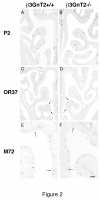
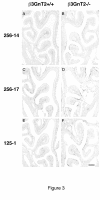
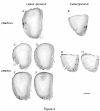

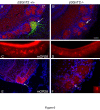

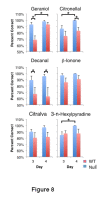
Similar articles
-
β3GnT2 maintains adenylyl cyclase-3 signaling and axon guidance molecule expression in the olfactory epithelium.J Neurosci. 2011 Apr 27;31(17):6576-86. doi: 10.1523/JNEUROSCI.0224-11.2011. J Neurosci. 2011. PMID: 21525298 Free PMC article.
-
Axonal Odorant Receptors Mediate Axon Targeting.Cell Rep. 2019 Dec 24;29(13):4334-4348.e7. doi: 10.1016/j.celrep.2019.11.099. Cell Rep. 2019. PMID: 31875544 Free PMC article.
-
Semaphorin 3A-mediated axon guidance regulates convergence and targeting of P2 odorant receptor axons.Eur J Neurosci. 2004 Apr;19(7):1800-10. doi: 10.1111/j.1460-9568.2004.03304.x. Eur J Neurosci. 2004. PMID: 15078553
-
Odorant receptor gene choice and axonal projection in the mouse olfactory system.Results Probl Cell Differ. 2009;47:57-75. doi: 10.1007/400_2008_3. Results Probl Cell Differ. 2009. PMID: 19083127 Review.
-
Activity-dependent formation of the topographic map and the critical period in the development of mammalian olfactory system.Genesis. 2024 Feb;62(1):e23586. doi: 10.1002/dvg.23586. Genesis. 2024. PMID: 38593162 Free PMC article. Review.
Cited by
-
Learning peptide recognition rules for a low-specificity protein.Protein Sci. 2020 Nov;29(11):2259-2273. doi: 10.1002/pro.3958. Epub 2020 Oct 5. Protein Sci. 2020. PMID: 32979254 Free PMC article.
-
Conservation of Specificity in Two Low-Specificity Proteins.Biochemistry. 2018 Feb 6;57(5):684-695. doi: 10.1021/acs.biochem.7b01086. Epub 2017 Dec 29. Biochemistry. 2018. PMID: 29240404 Free PMC article.
-
Adaptive olfactory circuitry restores function despite severe olfactory bulb degeneration.Curr Biol. 2023 Nov 20;33(22):4857-4868.e6. doi: 10.1016/j.cub.2023.09.061. Epub 2023 Oct 18. Curr Biol. 2023. PMID: 37858342 Free PMC article.
-
Deletion of Type 3 Adenylyl Cyclase Perturbs the Postnatal Maturation of Olfactory Sensory Neurons and Olfactory Cilium Ultrastructure in Mice.Front Cell Neurosci. 2017 Jan 19;11:1. doi: 10.3389/fncel.2017.00001. eCollection 2017. Front Cell Neurosci. 2017. PMID: 28154525 Free PMC article.
-
Dense and Persistent Odor Representations in the Olfactory Bulb of Awake Mice.J Neurosci. 2024 Sep 25;44(39):e0116242024. doi: 10.1523/JNEUROSCI.0116-24.2024. J Neurosci. 2024. PMID: 39187379
References
Publication types
MeSH terms
Substances
Grants and funding
LinkOut - more resources
Full Text Sources
Molecular Biology Databases
Miscellaneous

